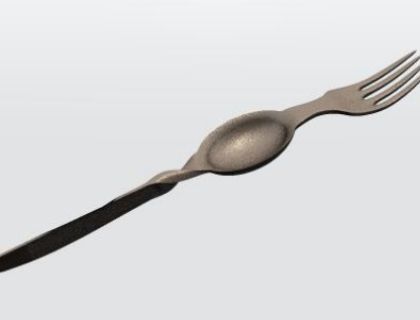The Making of Sporknik

. . . is a truly new dining experience. It has now been officially featured in THE BERKSHIRE EAGLE following an interview Heather Bellow, the Eagle’s investigative reporter, had with me in a tiny yet quite popular cafe in Great Barrington, Massachussets.
Few people know the real story behind this invention. It would take another, more extended interview by a specialist in modern design, 3D software and marketing with my son-in-law Thomas Murphy (we call him Tom) to get all the facts even remotely covered. But here is an abbreviated account, in which my only modest contribution will be shown to be merely conceptual, of the type What If, many years ago.
But I’m getting ahead of myself. Think of the time after Thanksgiving dinner, smell of turkey and gravy and all the other goodies still in the air, most of the 35 or so guests left or retired to bed, when I suddenly remembered a drawing I made many years ago. At that time I was in the habit of doodling with a fine ink pen on the pages of a little moleskin-kind of book before the Moleskin brand was invented.
These drawings were of fantastic plants, walking octopuses, possible steeples of possible churches, and an attempt to draw Kurt Vonnegut’s famous energy quantum used to propel spaceships, called Universal Will To Become. And there was also my drawing of a dining utensil that combined the functions of knife, spoon and fork in such a way that it was impossible to use — with the fork on one side and the knife on the other, and the spoon in the middle.
The idea was, if you wanted to use the fork you would have to grab the knife and hurt yourself. If you wanted to use the knife you would be in danger of piercing yourself by holding on to the fork part. As to the spoon — its use would be forbidden on the grounds of topology as it would never reach the surface of the soup. Besides, the handle on either side posed the same hazards as the use of the fork or knife alone.
Now as I remembered this drawing, perhaps inspired by regular tableware, used and unused, still arranged on the table, I asked Tom, whom I know to be proficient with the BLENDER software, if he could render my idea in three dimensions in the computer, a step, as it were, to its birth as a tangible thing in the world we live in.
He said Sure, and as I watched in amazement he created a rectangular slab on the screen, divided and deformed it according to the conventions of forks, spoons and knives we are all used to, for instance that the table knife is not pointed and that a decent table fork has four prongs, not three or five. We decided that the contraption had to have a length of eleven inches — unusually large as silverware goes, but making allowance for the fact that as many as three utensils had to be accommodated along the linear dimension. This all happened within an hour, even less.
As far as I was concerned, after he gave the utensil a distinct surface texture and metallic appearance, the job was done, but here comes the amazing part of the story: there is SHAPEWAYS, a website that features many objects that exist in concept only but can be printed on demand if it catches the fancy of a browsing buyer. Jewelry, chains, and dining utensils — you name it.
So this is how Sporknik was created, as a three-dimensional object waiting patiently in the wings of the stage of reality, along with other objects that might even be less useful. It has a name, and a price ($130.-) not too low (lest it isn’t recognized as something fancy) or too high (lest it would never find a single buyer), and it is posted on a website where can be inspecte from all angles by a 3D visualization tool.
It passed the site’s test for material integrity and stability, and all it needs now is a buyer.

Leave a Reply